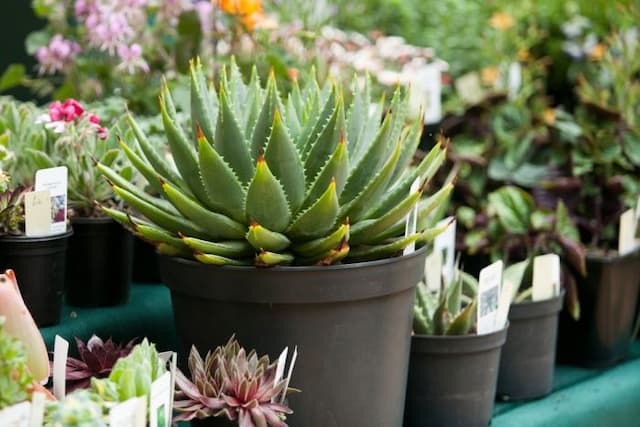Red Hot Poker Kniphofia 'Rich Echoes'

ABOUT
Kniphofia 'Rich Echoes', commonly known as Red Hot Poker or Torch Lily, is a visually striking perennial plant. It is known for its vibrant flower spikes that are reminiscent of a flaming torch. The blossoms are arranged in dense clusters on top of sturdy, upright stems, displaying a gradation of color that typically ranges from warm orange to yellow hues, evoking the image of a glowing ember. The flowers are tubular in shape, which makes them particularly appealing to hummingbirds and other pollinators. Beneath the floral display, the plant has a tuft of arching, grass-like foliage that serves as an attractive contrast to the upright inflorescences. These leaves are typically a deep green color, adding to the overall lush appearance of the plant. The striking combination of the foliage and vivid flower spikes makes the Red Hot Poker a prominent feature in any garden that boasts of this fiery specimen.
About this plant
 Names
NamesFamily
Asphodelaceae
Synonyms
Red Hot Poker, Torch Lily, Poker Plant
Common names
Kniphofia 'Rich Echoes'.
 Toxicity
ToxicityTo humans
The Kniphofia 'Rich Echoes', commonly known as Red Hot Poker, is not considered highly toxic to humans. However, eating significant quantities of the plant may cause mild stomach upset in some individuals.
To pets
Red Hot Poker, the common name for Kniphofia 'Rich Echoes', is also not considered highly toxic to pets. If ingested, it might cause mild gastrointestinal discomfort, such as vomiting or diarrhea, but it is not typically associated with severe poisoning symptoms in household pets.
 Characteristics
CharacteristicsLife cycle
Perennials
Foliage type
Evergreen
Color of leaves
Green
Flower color
Mixed
Height
3-4 feet (0.91-1.22 meters)
Spread
2 feet (0.61 meters)
Plant type
Herb
Hardiness zones
6
Native area
South Africa
Benefits
 General Benefits
General Benefits- Attractive blooms: Kniphofia 'Rich Echoes', commonly known as Red Hot Poker, produces vibrant, torch-like flowers that add bold color to the garden.
- Pollinator-friendly: The nectar-rich flowers attract bees, butterflies, and hummingbirds, supporting local ecosystems.
- Drought tolerance: Once established, Red Hot Pokers are quite drought-resistant, making them suitable for water-wise gardens.
- Easy to care for: This perennial is low-maintenance, requiring minimal care once it is settled in the right conditions.
- Seasonal interest: Red Hot Pokers bloom from late spring to early summer, providing seasonal interest when many other plants are not in peak display.
- Architectural value: The tall flower spikes and grass-like foliage provide striking architectural value to landscaping designs.
- Longevity: They are long-lived perennials that can remain in the same spot for several years, reducing the need for frequent replanting.
- Versatility: Red Hot Pokers can be used in a variety of garden settings, including borders, meadow plantings, and contemporary gardens.
 Medical Properties
Medical PropertiesThis plant is not used for medical purposes.
 Air-purifying Qualities
Air-purifying QualitiesThis plant is not specifically known for air purifying qualities.
 Other Uses
Other Uses- Textile Dyeing: The roots of the Red Hot Poker plant can be used to create a natural dye, providing a range of colors from yellow to green depending on the mordant used.
- Photography: The striking blooms of the Red Hot Poker make it a popular subject for photographers, particularly those interested in capturing the beauty of garden flowers.
- Floral Arrangements: Red Hot Poker flowers can be used in fresh or dried floral arrangements, where their elongated inflorescence adds an exotic touch.
- Edible Flowers: The blooms of the Red Hot Poker are edible when young and can be used to add a mild sweetness to salads or desserts.
- Craft Projects: Dried Red Hot Poker flowers can be incorporated into craft projects such as homemade paper, providing texture and color.
- Mood Influencer: The vibrant colors of the Red Hot Poker can be used in gardens and landscape designs to create a warm and inviting atmosphere.
- Garden Borders: The upright form and vertical lines of the Red Hot Poker can be used to provide structure and contrast in garden borders.
- Nectar Source: Red Hot Poker serves as a nectar source for hummingbirds and bees, making it a beneficial plant for pollinator gardens.
- Companion Planting: When planted in vegetable gardens, the Red Hot Poker's colorful flowers can help attract pollinators to enhance vegetable plant fertilization.
- Symbolism: In some cultures, the Red Hot Poker plant is used symbolically in gardens to represent energy and a passionate nature.
Interesting Facts
 Feng Shui
Feng ShuiThe Red Hot Poker is not used in Feng Shui practice.
 Zodiac Sign Compitability
Zodiac Sign CompitabilityThe Red Hot Poker is not used in astrology practice.
 Plant Symbolism
Plant Symbolism- Stand Out in a Crowd: With its uniquely shaped flower spikes and vibrant color, the Red Hot Poker symbolizes the ability to attract attention and stand out among others.
- Attraction: The brightness and unique blossoms are often associated with drawing in positivity and interest, much like it attracts hummingbirds and other pollinators.
- Strength and Vibrancy: The Red Hot Poker's robust growth and lively hues symbolize a strong life force, vibrancy, and the capacity to thrive in challenging circumstances.
- Courage: The striking appearance of the plant can symbolize taking bold actions or having a fearless nature.
 Water
WaterFor the Red Hot Poker plant, consistent moisture is ideal, especially during the summer blooming period and in the first growing season to establish a deep, extensive root system. Water the plant roughly every week, ensuring the soil is moist but not waterlogged. Depending on your local climate and soil conditions, adjust watering frequency to account for rainfall. In general, provide the plant with about 1 inch of water per week, which translates to about 0.623 gallons for a square foot area. During hot, dry periods, you may need to water twice a week, while in cooler, wetter conditions, less frequent watering is necessary.
 Light
LightThe Red Hot Poker thrives best in full sun conditions, meaning at least 6 hours of direct sunlight daily. Position the plant in a spot where it can receive unfiltered sunlight for most of the day without being shaded by taller plants or structures. Partial shade is tolerable, especially in the hottest regions, but may result in fewer blooms.
 Temperature
TemperatureRed Hot Pokers are hardy and can tolerate temperatures as low as 10 degrees Fahrenheit, but they prefer a temperature range between 50 and 85 degrees for optimal growth. They can survive brief periods of colder winter temperatures but should be protected from extreme cold snaps by adding mulch or bringing them indoors if potted.
 Pruning
PruningPruning Red Hot Poker plants is primarily for aesthetic purposes and to remove spent flower stalks, which encourages new growth and can result in additional blooms. The best time to prune is after flowering has ceased, typically in the late summer or fall. Cut the flower stalks down to the base of the plant, and if necessary, remove any dead or damaged foliage. Pruning once a year is usually sufficient.
 Cleaning
CleaningAs needed
 Soil
SoilThe Red Hot Poker (Kniphofia 'Rich Echoes') thrives best in well-draining soil that is rich in organic matter. A mix of loam, compost, and sand or perlite will facilitate proper drainage and nutrient retention. This perennial prefers a soil pH range of 6.0 to 6.5, which is slightly acidic to neutral.
 Repotting
RepottingRed Hot Poker plants generally do not require frequent repotting and can be left in the same pot for several years. They should be repotted only when they have outgrown their current container, which may be every 3 to 5 years.
 Humidity & Misting
Humidity & MistingRed Hot Poker plants are quite adaptable to varying humidity levels and do not have specific humidity requirements. They grow well in outdoor garden environments where they can tolerate the natural fluctuations in humidity.
 Suitable locations
Suitable locationsIndoor
Ensure full sun, well-draining soil, and occasional watering.
Outdoor
Full sun, well-drained soil, winter mulch in colder zones.
Hardiness zone
5-9 USDA
 Life cycle
Life cycleRed hot poker 'Rich Echoes' typically begins its life cycle as a seed, which, when sown, will germinate and grow into a young plant, called a seedling. As the seedling matures, it develops a rosette of narrow, grass-like leaves and a strong root system. Once established, the plant enters a vegetative state where it focuses on growing larger and producing more foliage. The next stage is the flowering period, where 'Rich Echoes' produces tall spikes topped with tubular flowers that range from coral at the top to cream at the base, usually in the late spring to early summer. After pollination by birds or insects, the flowers will fade, and seed capsules may form if conditions are suitable. Finally, as a perennial, the Red hot poker will enter a period of dormancy in colder months, conserving its energy to regrow the following spring.
 Propogation
PropogationPropogation time
Early spring
The most popular method for propagating the Kniphofia 'Rich Echoes', commonly known as Red Hot Poker, involves division. The best time to propagate by division is in the spring when the plant is emerging from dormancy and has not yet begun its full seasonal growth. To propagate by division, carefully dig up an established clump and use a sharp knife or spade to divide the root ball into sections, ensuring that each section has at least one growth point or fan of leaves. Replant each division at the same depth it was originally growing, spacing them about 18 inches (approximately 45 centimeters) apart to allow for adequate growth room. Water the new divisions well to help establish them. This clonal method ensures that the new plants will be true to the parent's characteristics, maintaining the vibrant flower color and plant form of 'Rich Echoes'.









